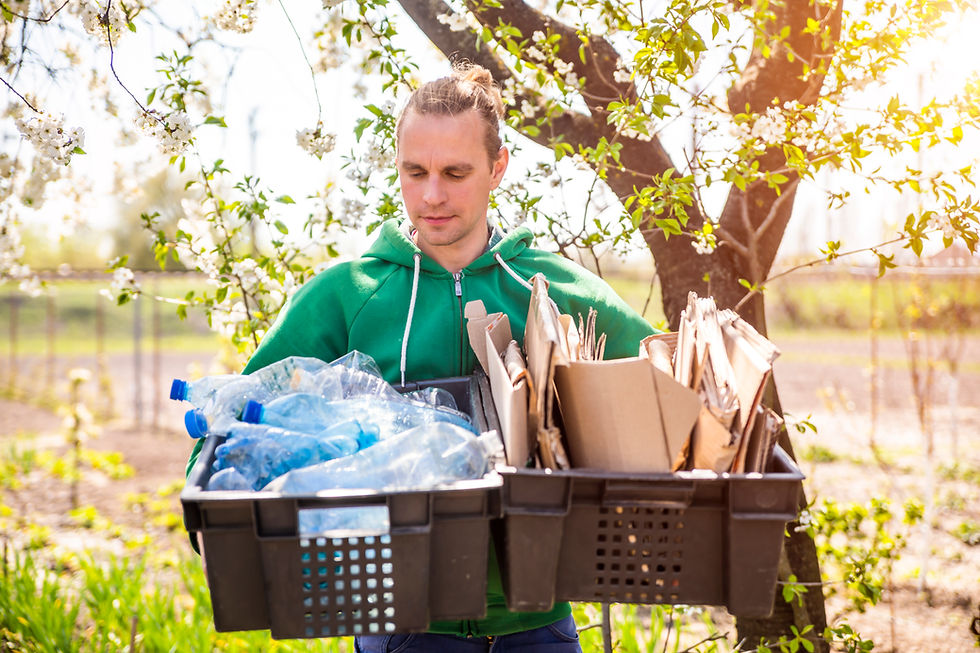About 5percent of plastics are recycled in the U.S., new report claims
- aardar

- May 10, 2022
- 4 min read

About 5percent of plastics are recycled in the U.S., new report claims
The report was announced on Wednesday, on the day the state's ban on carryout bags that are single-use came into effect. was one of its authors hails as an effective solution.
Just between 5% and 6% out of 46 million tonnes of plastics that are produced each year across the U.S. get recycled, which is a significant drop from the prior estimate of almost nine percent just several years ago, as per an analysis by two environmental groups that focuses on raising awareness about the environmental impact of plastics.
The report was published on Wednesday, the day after New Jersey's ban on carryouts with single-use bags was put into effect. One author, Judith Enck, said will bring about a change in the near future for the state.

"A majority of laws are implemented, and it takes a long time to get a positive effect," said Enck, an former U.S. Environmental Protection Agency official and currently a Professor of the University of Bennington College in Vermont. "You will see in the coming months less trash, such as bags littering trees and roads, thanks to law enforcement agencies and the New Jersey plastic bag law. There will be an obvious distinction."

Enck is also part of Beyond Plastics, a Bennington College-based group that was formed in the year 2019 with the intention of creating the foundation for an "effective opposition to plastic pollution." Beyond Plastics paired to conduct this study The Last Beach Cleanup, an organization based in California, founded in the same time by Jan Dell, a chemical engineer, to inform the general public about.
How much plastic is actually recycled?
"The currently 2021 U.S. plastic recycling rate is estimated to be between 5 to 6%," the report says. "Factoring in other loss that isn't quantified for instance, plastic waste that is collected under the pretense of recycling which is burnt, instead that the U.S.'s actual rate of recycling plastic could be lower."

Enck claimed that it fills the void that was left by the EPA's refusal to revise its own recycling data. The agency announced an estimated recycling rate of 8.7 percent in 2020 however, that figure is based upon an estimation from the year 2018. The EPA did not release an update in November.
To bridge the gap to fill in the gap, the two groups gathered information taken from U.S. National Academies of Sciences, Engineering and Medicine as well as various "waste engineers." They claim the general public believes that recycling rates are higher.

Since then, plastic has become ubiquitous. Take for instance that Americans produced around 60 pounds of waste made of plastic in the year 1980, as per the report. In 2018, the amount increased to 218 pounds, which is a growth of 263.
What kinds of plastics are recycled?
In actuality, Enck said, most municipalities only recycle numbers. 1 - and 2-plastics. These are indicated at the side of the containers. Philadelphia (and many municipalities) lists the different kinds of plastics that residents can put within recycling bins. They are listed on website.
No. 1 containers are made up of polyethylene terephthalate. It is also commonly referred to as PET or PETE. It is used to create water as well as soda bottle. No. 2 containers are made of high-density Polyethylene, also known as HDPE. They're typically used to create shampoo bottles, milk jugs as well as detergent bottle.

There are seven kinds of plastics which can be identified with the recycling symbol. People often mix them with the Nos. 1 and 2 and contaminate the loads so that facilities for sorting aren't able to sort and recycle. Therefore, contaminated materials are usually packed for landfills or to be burned.
Plastic bags aren't acceptable for pickup by municipal authorities. They could block machinery at recycling facilities. Styrofoam, yogurt and microwaveable food containers are typically not recyclable. Plastic packaging that is flexible, which is a fast expanding product that is used to create bags for granola that can be sealed, large baggies for pet foods, as well as packaging for a variety of other products, are also not recyclable.
Enck However, she does not want people to become discouraged. "We certainly would like people to continue recycling," she said.
Can anything be recycled?
Enck says that cardboard and paper have recycled rates of around 68 percent. Metals like aluminum cans, as well as glass, like bottles, have higher recycling rates than plastics.

Americans were lured into believing that plastics could be recycled since they were delivered to China for years, she explained. However, China began to stop taking American as well as European plastics in the year 2018. The two countries then began sending their goods products to Vietnam, Thailand and Malaysia until the countries resisted.

In the meantime, haulers and municipalities have been scrambling to find new markets for domestic consumption and upgrade facilities to sort recyclables that are contaminated with non-recyclable materials.
"The issue is not in the idea or the process for recycling but in materials themselves. Recycling of plastics has failed repeatedly," the report states. "Even when the millions of tons of plastic waste were exported to China every year, the recycling of plastics did not get to 10 percent.
"Despite the utter failure of recycling plastics, the packaging, plastics and other industries have waged an over a decade-long campaign of misinformation to spread the myth that plastic can be recycled."






Commentaires